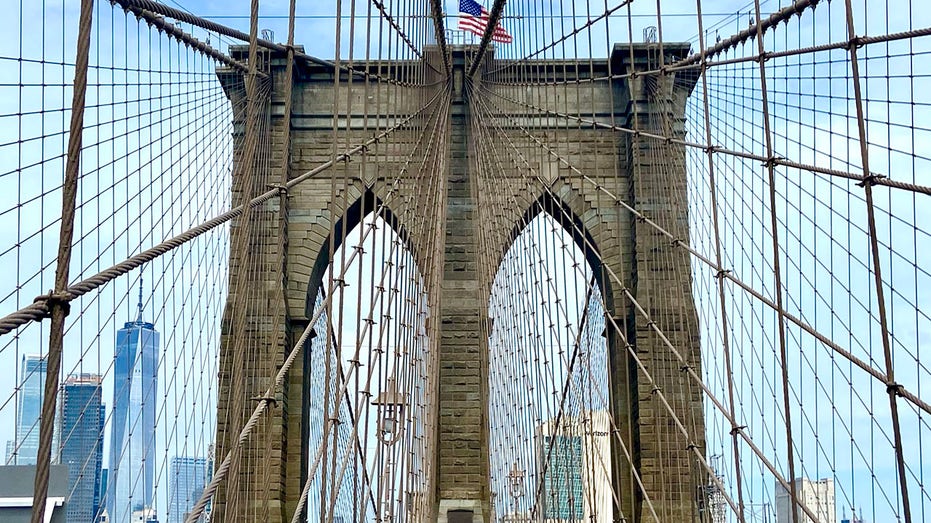On this day in history, May 24, 1883, the Brooklyn Bridge — which spans the East River and connects the boroughs of Manhattan and Brooklyn — opened as the longest suspension bridge in the world.
The Brooklyn Bridge was designed by John A. Roebling, notes the official New York City website.
Construction began in 1869 and was completed in 1883.
“At the time, it was the longest suspension bridge in the world,” says the site.
ON THIS DAY HISTORY, MAY 23, 1900, SGT. WILLIAM H. CARNEY RECEIVES MEDAL OF HONOR
That day, the Brooklyn Bridge opened to great fanfare.
With schoolchildren and workers enjoying a rare holiday, thousands flocked from Brooklyn and Manhattan to attend the dedication, led by President Chester Arthur and New York Gov. Grover Cleveland, according to Oxford University Press.
“The crowd cheered as Emily Roebling — wife of the chief engineer and an integral figure in its construction — became the first person to cross [the bridge]. That night, fireworks illuminated the sky,” the same source indicated.
The bridge connecting Brooklyn and Manhattan had long been appealing but faced many obstacles.
“The swift waters of the East River seemed impossible to span. Also, any bridge would have to rise high above the river to allow the tall ships to pass beneath,” Oxford University Press also noted.
The two granite foundations of the Brooklyn Bridge were built in timber caissons, or watertight chambers, sunk to depths of 44 feet on the Brooklyn side and 78 feet on the New York side, as History.com reported.
ON THIS DAY IN HISTORY, APRIL 4, 1973, WORLD TRADE CENTER OPENS IN NYC, CROWNED BY TALLEST TOWERS ON EARTH
“At that time, little was known of the risks of working under such conditions, and more than a hundred workers suffered from cases of compression sickness, or the ‘bends,’ which is caused by the appearance of nitrogen bubbles in the bloodstream that result from rapid decompression,” the same site noted.
Also, there were other construction accidents, such as collapses and fire.
Hailed as “The Eighth Wonder of the World,” the Brooklyn Bridge was a truly a feat of civil engineering. Thousands of people made the first public crossing with fanfare and fireworks on its opening day, according to reports.
MEET THE AMERICAN WHO CONJURED UP ‘LEGEND OF SLEEPY HOLLOW’: WASHINGTON IRVING, FIRST US CELEBRITY AUTHOR
Designer John Roebling’s son, Washington Roebling, took up the role of chief engineer of the project, following his father’s death, but contracted the aforementioned “bends” two years into construction while overseeing the work.
He was permanently paralyzed, said WNYC.
Washington Roebling’s wife, Emily, acted as chief engineer on site in his stead, according to the same site, and was regarded as the first female field engineer.
“Emily [Roebling] began relaying her husband’s instructions and, building upon her own working technical knowledge, she frequently consulted with contractors and assistant engineers on the project. Emily oversaw the construction to the bridge’s completion, and though she was well-respected by the engineers and city officials she worked with, she was granted no official title in relation to the project,” the site indicates.
Between the years 1944 and 1954, a comprehensive reconstruction of the Brooklyn Bridge took place, noted NYC.org.
“The inner and outer trusses were strengthened, new horizontal stays were installed between the four main cables, the railroad and trolley tracks were removed, the roadways were widened from two lanes to three lanes, and new approach ramps were constructed,” the source notes.
CLICK HERE TO SIGN UP FOR OUR LIFESTYLE NEWSLETTER
Also, “additional approach ramps to the FDR Drive were opened to traffic in 1969.”
The iconic bridge was designated a National Historic Landmark in 1964 and a National Historic Civil Engineering Landmark in 1972.
Known for its stone arches, the Brooklyn Bridge supports six lanes of vehicles (no trucks) and a shared pedestrian and bicycle path, as NYC.org points out.
The New York City Department of Transportation says that each day, over 4,000 pedestrians and 3,100 bicyclists cross the elevated boardwalk of the Brooklyn Bridge — while more than 120,000 vehicles use the bridge’s roadway, according to Brooklyn Waterfront History.
In Sept. 2021, a two-way protected bike lane opened along the Brooklyn Bridge.
For more Lifestyle articles, visit www.foxnews.com/lifestyle.
Source
